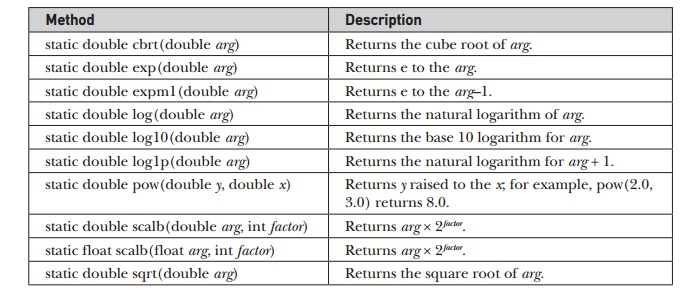Chapter: Java The Complete Reference : The Java Library : Exploring java.lang
Math - java.lang
Math
The Math class contains all the floating-point functions that are used
for geometry and trigonometry, as well as several general-purpose methods. Math defines two double constants: E
(approximately 2.72) and PI
(approximately 3.14).
Trigonometric
Functions
The following methods accept
a double parameter for an angle in
radians and return the result of their respective trigonometric function:
Method : Description
static double sin(double arg) : Returns the
sine of the angle specified by arg in radians.
static double cos(double arg) : Returns the
cosine of the angle specified by arg in radians.
static double tan(double arg) : Returns the
tangent of the angle specified by arg in radians.
The next methods take as a parameter the result
of a trigonometric function and return, in radians, the angle that would
produce that result. They are the inverse of their non-arc companions.
Method : Description
static double asin(double arg) : Returns the
angle whose sine is specified by arg.
static double acos(double arg) : Returns the
angle whose cosine is specified by arg.
static double atan(double arg) : Returns the
angle whose tangent is specified by arg.
static double atan2(double x, double y) :
Returns the angle whose tangent is x/y.
The next methods compute the hyperbolic sine,
cosine, and tangent of an angle:
Method : Description
static double sinh(double arg) : Returns the
hyperbolic sine of the angle specified by arg.
static double cosh(double arg) : Returns the
hyperbolic cosine of the angle specified by arg.
static double tanh(double arg) : Returns the
hyperbolic tangent of the angle specified by arg.
Exponential
Functions
Math defines the following exponential methods:

Rounding
Functions
The Math class defines several methods that provide various types of
rounding operations. They are shown in Table 17-16. Notice the two ulp( ) methods at the end of the table.
In this context, ulp stands for units in the last place. It indicates
the distance between a value and the next higher value. It can be used to help
assess the accuracy of a result.



Miscellaneous
Math Methods
In addition to the methods
just shown, Math defines several
other methods, which are shown in Table 17-17. Notice that several of the
methods use the suffix Exact. These
were added by JDK 8. They throw an ArithmeticException
if overflow occurs. Thus, these methods give you an easy way to watch various
operations for overflow.


The following program
demonstrates toRadians( ) and toDegrees( ):
// Demonstrate toDegrees() and toRadians().
class Angles {
public static void main(String args[]) { double
theta = 120.0;
System.out.println(theta + " degrees is
" + Math.toRadians(theta) + " radians.");
theta = 1.312;
System.out.println(theta + " radians is
" + Math.toDegrees(theta) + " degrees.");
}
}
The output is shown here:
120.0 degrees is 2.0943951023931953 radians.
1.312 radians is 75.17206272116401 degrees.
StrictMath
The StrictMath class defines a complete set of mathematical methods that parallel those in Math. The difference is that the StrictMath version is guaranteed to generate precisely identical results across all Java implementations, whereas the methods in Math are given more latitude in order to improve performance.
Compiler
The Compiler class supports the creation of Java environments in which Java bytecode is compiled into executable code rather than interpreted. It is not for normal programming use.
Related Topics